Thrive
City questions promises from Gas Plant/Trop developers
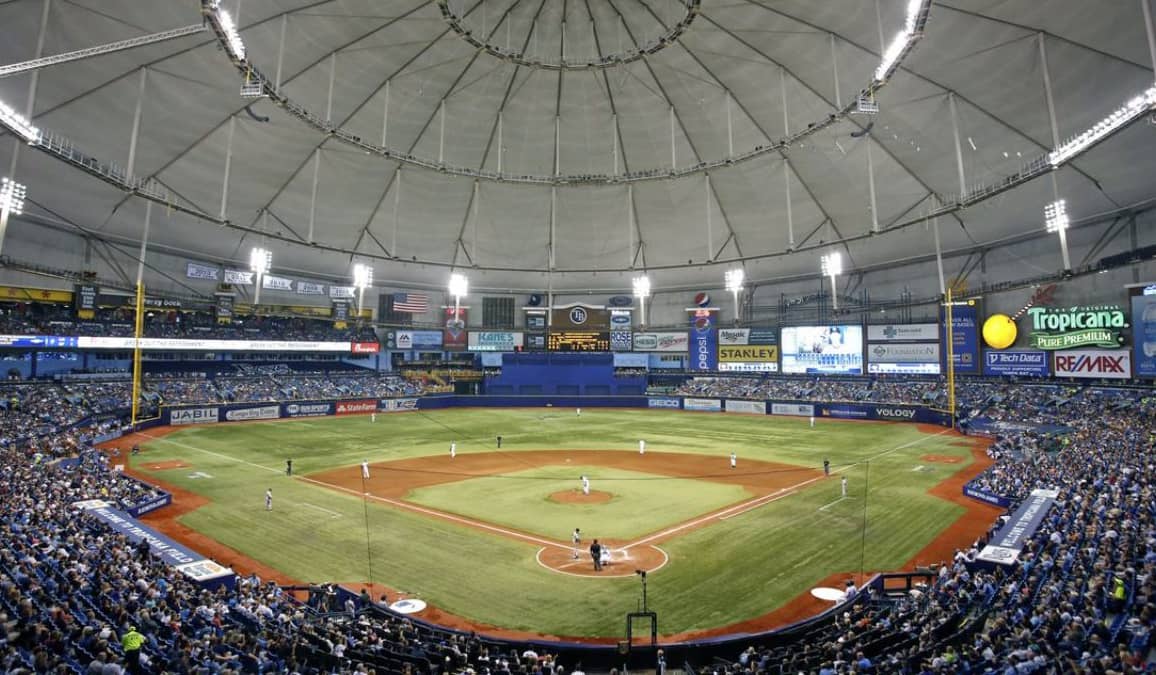
As St. Petersburg Mayor Ken Welch determines the master developer that will transform the 86-acre Tropicana Field and Gas Plant District property – a multi-generational project – city officials are asking the competing development teams additional questions.
This week, the city released its list of questions to the four development teams, clarifying points and promises made in each of the proposals they’ve received.
The publication of the questions and responses comes after the city hosted a community event last week where the teams presented their visions for the site to the public.
Welch will announce his selection of the master developer at the 2023 State of the City address Jan. 30th at City Hall.
A highlight of the city’s questions and responses from developers:
The questions and responses have been edited and paraphrased for clarity.

Tampa Bay Rays’ rendering of its proposed redevelopment of the Trop site. All renderings were provided.
Tampa Bay Rays and Hines
Does the team have adequate local resources to implement this project?
Gensler, the master planner and architect, has a Tampa office with 60 design professionals that will have boots on the ground. Kimley Horn, the civil engineer, has an office in St. Petersburg of 50 engineering professionals that will deliver this project. Kimley Horn has delivered complex projects like the St. Pete Pier, working closely with the city. Architect firm Storyn is located a few blocks from the site and will focus on storytelling through urban planning and design to knit the Historic Gas Plant development to the local neighborhoods. From an employment perspective, Hines and the Rays have met with St. Pete Works, the Pinellas County Urban League, Boley Centers, P-Tech, the Pinellas Opportunity Council and others to begin to create a community workforce. We have identified hundreds of small minority-owned businesses that can perform services needed for the project. We also will develop and identify additional local, minority businesses through our restorative enterprise program.
Please provide more information on the funding sources to be used for development in addition to the equity investment from the partners.
In addition to the general partner equity commitment by Hines and the Rays, each project within the master plan will be capitalized through a combination of construction financing and limited partner equity. Target construction financing typically ranges from 50-65% loan-to-cost and will be sought on a project-by-project basis from a combination of regional, national and international construction lenders. Hines has extensive experience having already created numerous qualified opportunity zone funds throughout the country. Hines and the Rays have proactively approached several limited partner equity investors who have expressed strong interests in Phase 1 of the Historic Gas Plant District redevelopment.
Please clarify. You indicate a total of 5,728 residential units will be produced, but then indicate that 6,328 combined units of market rate and affordable will be produced.
The proposed masterplan contemplates a total of 5,728 residential units on-site, inclusive of 4,869 market rate units and 859 affordable/workforce housing units. In addition to the 5,728 residential units on-site, Hines and the Rays are committing $15 million, which will impact an estimated 600 residences off-site (6,328 units or residences in total) through various homeownership and rental assistance programs in South St. Pete.
Your proposal outlines a total infrastructure cost of $150.4 million, noting that these costs will be financed through a combination of TIF (tax increment financing) and other state or local financing tools. Please explain the state or local financing sources you would seek.
Hines and the Rays’ vision for the site will result in transformational economic impact, including significant new tax revenue, resulting from the construction of a new Rays ballpark and over 8 million square feet of development. Hines has a 20-plus year relationship with MBS Capital Markets, a FINRA-registered, Florida-based boutique investment banking firm that specializes in special tax district finance, including land-secured, utility, and public-private partnership tax-exempt financing.

SHCP’s rendering of Palm Court.
Sugar Hill Community Partners
What private-public projects, other than the Downtown Commons (a mixed-use destination anchored by the Sacramento Kings stadium), supports JMA’s experience?
- Barclays Center in Brooklyn, New York: Machete Group represented the NBA’s Brooklyn Nets on development of Barclays Center, a new multi-purpose arena in downtown Brooklyn. The project included partnerships with a number of public stakeholders, including the Brooklyn Borough President, the city and State of New York.
- TQL Stadium in Cincinnati, Ohio: Machete Group represented Major League Soccer’s FC Cincinnati on the development of TQL Stadium, a new soccer venue, and on the planning and entitlement of a planned mixed-use district adjacent to the stadium in partnership with the City of Cincinnati.
- Robles Park in Tampa: PMG is currently developing Robles Park, a 1,400-plus unit affordable housing project in partnership with the Tampa Bay Housing Authority.
- Hub RTP in Durham, North Carolina: KDC has partnered with Durham County to deliver the Hub RTP project in North Carolina’s Research Triangle Park. The project includes 1,200 multi-family residential units, 425 hotel keys, up to 1 million square feet of Class A office space and a 16-acre park.
- CentrePoint P3 in Fort Worth, Texas: KDC partnered with the City of Ft. Worth to develop a 1,300-acre former international airport. The project includes 800,000 square feet of office, 600,000 square feet of industrial, 150,000 square feet of retail, 120 acres for multifamily development, 600 hotel room keys, and two miles of infrastructure.
What are the options contemplated for funding the development, including the additional funding needed to construct the African American History Museum?
The most efficient way to finance site infrastructure is via a conventional designer TIF that bonds against the site’s future property taxes. This “let growth pay for growth” model does not require any capital, backstop, or guarantee from the city or county. We are also proposing a CDD – essentially a self-tax on the developer – that will contribute approximately $30 million of net proceeds. Our analysis of project-derived tax capacity to pay for site infrastructure does not include additional bed tax and other sales tax revenues within the district. We anticipate that these bondable revenue streams could, if necessary, support additional proceeds to support public infrastructure. The team will leverage its expertise in securing state and federal grants to offset specific costs related to infrastructure, brownfield remediation, stream restoration and resiliency. We believe that substantial demand exists for a large conference facility in St. Petersburg and have accordingly proposed a 150,000-square-foot venue. We project the conference facility will require $39 million of public financing, which we suggest be funded through bed tax revenues. With respect to the construction of the new African American History Museum, we have pledged to make a $1 million contribution to the project, provide free land and project management services. We have also committed to working with the museum team to identify additional sources of funding, including the possibility of directing a portion of the unallocated Community Equity Endowment funds (projected to be $20 million) to the project.
Describe how the $292 million public funding commitments identified in the proposal will be paid for.
Our proposal assumes that bonds will be issued for each phase to fund the approximately $292 million in improvements necessary for the project. The bonds would be repaid over a 30-year period from a combination of sources, including a new TIF limited to the project pledging city and county CRA (Community Redevelopment Agency) property tax revenues, which we expect our project will contribute $336 million to over 20 years. Other sources include the community development district assessment revenues. Please note that SHCP team member MuniCap, a nationally recognized leader in public financing, has prepared detailed cash flow schedules.
Proposing 2,291 affordable units on-site and another 325 units off-site is significant; however, who will procure the land to construct the off-site units?
- St. Petersburg Housing Authority: SPHA controls multiple parcels that can, through rehabilitation and development, accommodate between 125 and 165 units of new affordable housing. We anticipate that delivery of the newly renovated or developed affordable housing can occur in 2025.
- Commerce Park: Relocating the new African American History Museum to the Gas Plant frees up the 5.3-acre parcel on 22nd Street South currently earmarked for the museum for development. The site can accommodate approximately 240 affordable housing units, which can be delivered in 2025.
- St. Pete College: SPC owns a parking lot in South St. Petersburg that we believe is under-utilized and an excellent candidate for affordable housing development. Per a review, the site can accommodate between 210 and 315 affordable housing units.
- There are additional housing sites and we have proposed allocating a third of projected Community Equity Endowment (CEE) proceeds to the renovation and development of single-family affordable homes.
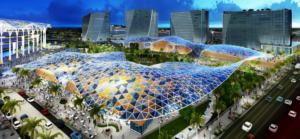
50 Plus One Sports’ rendering of its Booker Creek Commons concept.
50 Plus One Sports
What experience does your team have implementing community benefits at a district scale?
JLL has significant experience with community benefits agreements. Tom DeMuth, a principal at Fresh Coast Development Partners, has significant experience implementing community benefits at a district scale both as a developer and an attorney. DeMuth developed the South Water Works project in Milwaukee, Wisconsin. The South Water Works project was a renovation of a large manufacturing campus creating 650 residential apartments, 50,000 square feet of office space, 40,000 square feet of retail space, 50,000 square feet of live theatre and several open space venues. We used new market tax credits to fund a portion of the renovation and we put in place a community benefits agreement for the entire campus. Pursuant to the CBA, we established a job training program, required businesses in the development to hire minority individuals, built a meeting space for neighborhood groups and funded a program to assist with the development of affordable housing.
The proposal includes a revenue-sharing plan that projects the city’s share of the revenue from the project to be over $700 million within the first 20 years, with the city’s share of the revenue to be roughly $2.97 billion after 40 years. How was the projected revenue determined, and what is the payment schedule?
We have attached a 60-year cash flow analysis to this response. The cash flow shows the estimated amount the city will receive each year during the first 60 years. To determine the city’s projected revenue share we prepared an analysis of each property type (hotels, retail, residential, etc.). We will use the hotel analysis as an example of how we calculated the revenue share with the city.
Can you provide additional detail on the University of New Orleans Sports and Entertainment District project? Specifically, please elaborate on 50 Plus 1 Sports’ role, the form of partnership with the university, the status of the project, and its anticipated completion date.
50 Plus 1 Sports is acting in the same role in the University of New Orleans Sports and Entertainment District as it is acting in the St. Petersburg project. In New Orleans, 50 Plus 1 Sports is a real estate finance company focused on social equity. The university retained 50 Plus 1 and its entire team to develop, design, finance, build and maintain a large mixed-use project which is adjacent to a to-be-built football stadium and basketball arena. The team will design, finance and build the football stadium and the basketball arena, but 50 Plus 1 will not own or operate the sports components of the project. The university has a signed NDA with 50 Plus 1 Sports and the university is expected to sign an agreement and ground lease Jan. 5. The project will be built in phases and the last phase will be finished in 2028. The cost to complete the project is $2.1 billion.
What is the rationale to delay the first phase until 2031?
We are not delaying the opening of the first phase until 2031. On page 123 of our response, it states the development of the first phase will commence in 2023 and end in 2031. In our cash flow statements attached to our response, we show that we will start collecting rent in 2027-2028. We strongly believe we will start collecting rent as early as 2025, but we wanted to take a conservative position in our cash flow statements since we will be sharing revenue with the city, we did not want (to) over promise.
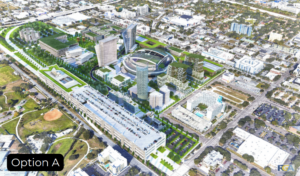
Restoration Associates’ rendering of Option A for the Rays stadium.
Restoration Associates
The timing and development plan is unclear. Please provide a clear timeline for the project.
The timing of our phases is three to five years after a development agreement is executed between the City and Restoration Associates. Phase 1 entails building a self-storage facility. Phase 2 entails the construction of an intermodal center (housing multiple modes of transit) and attainable housing. We are actively researching the time frames required to apply for and gain governmental required approvals for the design and construction of the intermodal center directly connected to Interstate I-275, replacing I-175. This removal of the interstate allows the team to move forward with building 1,350 attainable/affordable residential units within five years, connecting to the intermodal center. Phase 3 is also dependent on the intermodal center and would create 450 market-rate residential stacked above ground-level retail that will activate the pedestrian walkway along First Avenue South. The next phases entail a research park, a convention center hotel, a museum, a memorial park and two options for the Rays’ stadium – either improving the existing stadium or building a new stadium.
What will the funding sources be for each phase of the development and what will be the equity investment from the development partners?
Phase 1, the self-storage facility, would be privately funded by Freedman Development for $28 million. Phase 2, the intermodal center and housing, would require public grant funding for 20-60% of it while the remainder would be funded through a private-public partnership. Florida Housing and the Pinellas Housing Finance Authority would cover 9% and 4% of the tax credit equity. Phase 3, the mixed-use plan for First Avenue South, would be private funding by Onicx with $57 million. Phase 4, calling for a research hub, would be privately funded by Brennan Investment with $100 million. RA listed other aspects of the entire district that would be privately funded as well. Regarding a new stadium, the group did not identify any available funding; however, the renovation of the existing stadium would cost $600 million and would be covered through tourist tax dollars, increment financing and a contribution from the Rays.
RA mentions 1,350 “attainable” units as part of phase 2, please be specific as to the income levels to be housed in these units.
Attainable housing is defined as a range of mixed-income housing. It is simply more affordable either because the units are smaller or shared spaces. Attainable units also include units that are not income-restricted or rent-restricted due to regulatory requirements but rather voluntarily. At this time, we can commit to 80% affordable (60% of the average median income or less), 10% workforce and 10% attainable through a reduced unit size.
What experience does your team have implementing large-scale mixed-use development? Please include any local qualifications if they exist.
- Allied Chemical manufacturing plant at Port Manatee: This was a joint venture with TRC Worldwide Engineering (a consultant listed herein to help design the intermodal center parking structure). The project scope includes the repair of a $200 million chlorine manufacturing facility as well as a 200,000-square-foot chlorine storage facility and office facilities. Construction is nearing completion. RA was responsible for identifying and coordinating all sub-consultants with the property owner to ensure the facility was properly built back.
- RA is currently involved as an owner’s representative for the 50-acre Little Harbor redevelopment in Ruskin as well as the renovation of the 10-story Harborside multifamily residential tower. This project involves over 1,000 multifamily units. RA is responsible for securing and coordinating all land-use consultants, designers and contractors for the investment company.


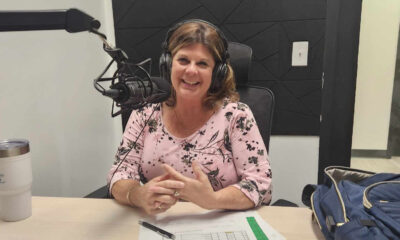

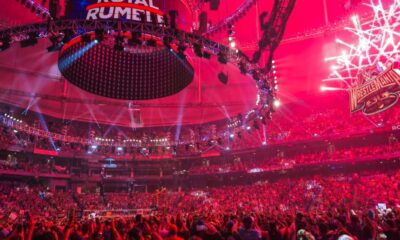

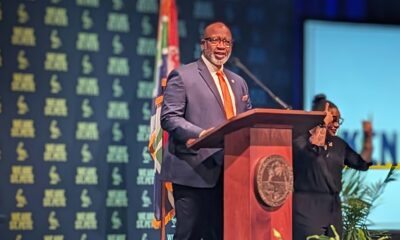

Shirley Hayes
January 17, 2023at6:11 pm
The Rays want to remain in St. Pete because it is cost effective for them. It will cost them entirely too much to move to Tampa even though in the long run, they will have better attendance in Tampa.I like 50 Plus One Sports, but believe Hines/Rays and Sugar Hill are front runners.
steve sullivan
January 13, 2023at7:45 pm
VSF, that is not legally possible due to jurisdictional right’s and the way that the Ray’s lease is written. If they leave they get no developer right’s. It’s in the current lease
VSF
January 13, 2023at4:46 pm
The Rays want to be in Tampa, not St. Pete. I believe their plan is to get development rights on the Gas Plant to help pay for a stadium in Tampa. That is why they won’t commit to stay in St Pete. Running a baseball team may require keeping other options open but this project is about the community and it’s history. Using the city of St Pete and the community as part of a plan to maximize leverage in Hillsboro does a disservice to us and is a sad reminder of the history of broken promises that this site has seen.
steve sullivan
January 13, 2023at12:47 pm
These proposals are not even close to Midtown says the person from the prior administration that selected Midtown. I personally liked the Midtown proposal when it was selected but Sugar Hill (SH) has improved upon what was. I question SH’s ability to execute, they have a spotty track record. Sugar Hill and Hines / Ray’s proposal’s actually allow for equity participation of the local investment community and citizen through the fractional investment model. I beleive that Sugar Hill will set aside 10% according to a team interview I saw by St. Pete Catalyst. Do I like their layout and strategy for housing? No! The design is not good and the number of residential units whether affordable or market rent are too heavy. Total housing should be reduced by 75% too allow for more office and retail. The site has to draw outsiders in order to be economically successful and not become an apartment community adjacent to an MLB stadium. 50 + 1 is the poster child for minority equity participation through its minority black owned ownership and participation requirement of 51% minority firm’s, yet it allows for flexibility of individual parcel acqusition via zoning by developer’s. Restoration Partner’s is a non starter. At the end of the day I predict that Mayor Welch, will call for Hines / Ray’s to work with Sugar Hill (by carving out the 17 acreas for the Ray’s to develop) or select Hines / Ray’s outright.
rob
January 13, 2023at11:56 am
I lived in St Louis where there’s an empty stadium the Rams just HAD to have the city build. It just cost them $500 million for leaving and they didn’t even blink
just saying….
Steve D
January 13, 2023at9:25 am
VSF, I don’t understand your question. Why would the Rays submit a proposal to build a stadium if they don’t plan on occupying it? Additionally, accepting their proposal practically guarantees their staying in St. Pete. Otherwise, I think they’ll leave. Most professional sports teams need revenue streams other than the the team to be successful now. Their flirtation with Tampa is, smartly, Plan B. Nashville and Charlotte are Plan C.
Alan DeLisle
January 12, 2023at7:31 pm
These proposals are not even close to Midtowns. Compare the Midtown term sheet that was negotiated against these proposals and the the city will wish it could rewind a year. The financial risk and amount of required investment for the city in any of these proposals is huge compared to Midtown. Thats what happens when you give up your leverage. I do hope that the city can negotiate a reasonable public-private partnership but it is not looking good.
Velva Lee Heraty
January 12, 2023at5:57 pm
Of all the proposals I felt Sugar Hill was the most creative and compelling. I like how they drew the outside neighborhoods into the mix in effect broadening the actual property to be more inclusive of the city as a whole.
Danny E White
January 12, 2023at4:45 pm
Nice job, Veronica Brezina!
VSF
January 12, 2023at4:40 pm
Why did the City not ask the Rays if they will stay in St. Pete if they are selected? Seems like a major risk to award anything to the same team that is in active discussions with Tampa. Also, their plans for affordable/workforce housing are the least ambitious of all the proposals. If we need to choose between baseball and what the community really needs, that seems like an easy choice.